How To Catch California Voles In The Garden
The Meadow Vole (Microtus californicus) is a native member of the rodent family, and found throughout the entire coastal range of California, and inland central valleys.
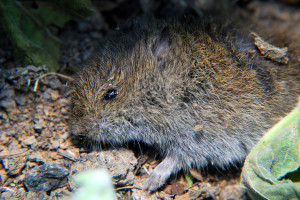
Halfway in size between a mouse and gopher, the California Meadow Vole is the scourge of the organic garden
Voles are somewhat mouse-like in appearance, approximately 5-8 inches in length, but with shorter tails than mice, and are occasionally confused with gophers. The difference is that for us, at least this year, they are significantly more populous, and far more destructive than gophers.
Vole Life History
Meadow voles thrive in habitats that are densely planted, where they can take refuge beneath ground covers and low growing shrubs, to help them avoid predation by hawks, owls, bobcats, and coyotes, and even common house cats.
Although individuals are reportedly short-lived, usually living less than 12 months, female voles can reproduce between 5-10 times per year, and average six young per litter. That's a potential for 60 additional voles, per female, per year.
Their home range is reportedly around a quarter of an acre. They don't hibernate, and are active all year round, although peak reproduction is usually during the spring months. They reside in networks of subterranean burrows, often with numerous voles per burrow.
Population levels fluctuate during the year, and from year to year. Some years gardeners experience very little or no vole activity, and other years, like this year for us, it becomes virtually impossible to grow anything.
Surveying Our Vole Damage
At the time we planted out the orchard we hadn't seen any voles. We asked a number of our neighbors if voles were a concern, and the consensus was that most had never seen one. Regardless, to be safe, we planned for voles and gophers while planting out our orchard by installing trunk guards on all the young trees. Now we're glad we did.
We didn't observe any vole damage in our gardens or orchard last year. By late spring this year though, we noticed we could see that meadow voles were clearly running amok on the orchard slope. I even had one shoot right across the top of my boot while out weeding one afternoon. Really, I felt it! As I looked more closely, I found numerous vole holes scattered across the orchard, and at certain times of the day, multiple voles could be spied shooting cross the slope from tunnel to tunnel like furry bullets!

Voles look like rocket-powered mice as they shoot out of one tunnel, and dive into an adjacent one. They hate spending time on the surface, except to feed.
One afternoon, in mid-February, I noticed a vole poking around under the gopher guards that protect the roots of one of our apple trees, but at least it was on the outside of the guard, not inside with the roots.
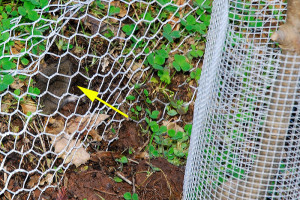
My first in person sighting of vole activity in the orchard
I checked the other trees, and didn't find any overt vole damage at that time. A few weeks ago though, I noticed that our Frost Peach tree was wilting. The same young tree, that after thinning most of the fruit last year, still yielded enough to make jam.
Root and trunk guards have proven to not be enough. The Frost peach will not produce peaches for jam this year.
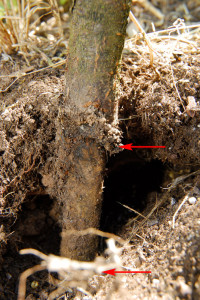
Once we excavated the soil, we found the voles has stripped 95% of the bark around the trunk of Frost BELOW the soil line (between the red arrows). Where's my shotgun?
Both this peach, and our Bosc Pear trees are now dying. All due to voles, and will need to be replaced this December, as the voles jumped not only the root guards, but also proceeded to tunnel under the trunk guards, a good few inches below the soil. We excavated the burrows, and were horrified at what we found. These vile voracious voles had succeeded in stripping the bark and cambium almost all the way around Frost, and at least half way around Bosc, spelling almost certain death for these trees.
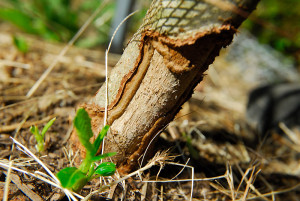
The tree is plumb, it was the photographer that was tilted. Regardless, this is the damage to the bark and cambium caused by voles to our Bosc pear earlier this spring.
The damage didn't stop there though. After a few days of warm weather at the start of summer, we noted that some of our tomato plants were wilting excessively. We searched for evidence of blight, or fusarium wilt, but the plants seemed otherwise healthy, just wilted.
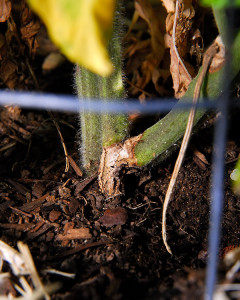
Wait...that's not wilt...
As I worked down the plants, I followed the main stem to the soil, and discovered the voles, in classic vole style, had destroyed more than 50% of the stems right at the soil line. These wounds have now scarred down, and the plants are holding on, but far from thriving.
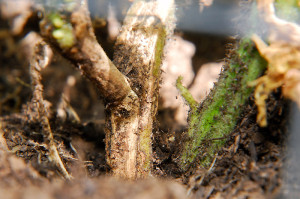
Scarring on the stem at the soil line of the Pineapple Heirloom tomato
We expect to have a significant reduction in tomato yields on those plants this year, as if the strangely cool weather hasn't set the plants back enough.
Voles, it seems, also have an enormous, and insatiable appetite for squash plants, especially winter squashes, and in particular our heirloom Musquee de Provence plants, ALL of which have now been completely obliterated.
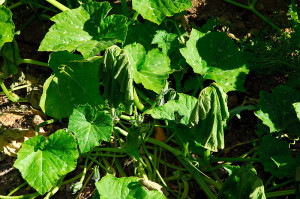
The sight of wilted leaves in the midst of the Musquee de Provence patch could only mean one thing...
I had planned to do a '2011 Great Squash Experiment' update this week. However, in the last 10 days our squash patch has been under heavy attack. We first noted occasional gnaw marks on some of the summer squash, like our Cocozelle.

Minor vole damage may go unnoticed
At that point we placed a number of traps in an attempt to determine exactly who was doing the damage.
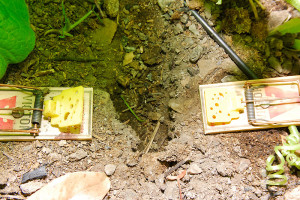
A pair of traps are placed perpendicular to the tunnel entrance
As voles hate to be out in the open, the traps were covered.
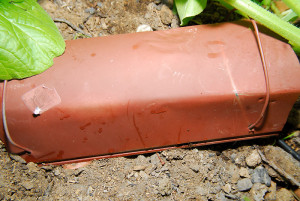
A folded piece of sheet metal, or gutter, can be placed over the traps to create a tunnel
Of course, we caught a varmint, it was a meadow vole.
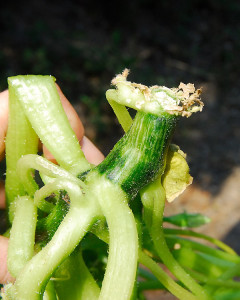
The hallmark of vole damage, over rabbit or squirrel, is that the stems are severed at the soil line. This Boston Marrow winter squash was cleanly separated from its roots by voles
Investigating the Musquee squash, we found the entire main stems had been severed at the soil line, with almost knife-like precision.
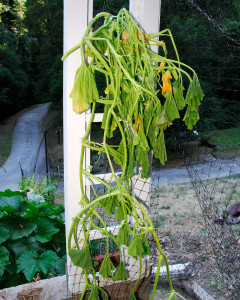
Boston Marrow, one of our most prolific squash for setting fruits, obliterated. The entire plant was severed at the root, and died.
In addition, a number of developing winter squash fruits on Boston Marrow, and Red Kuri, had been devoured, almost completely. Then we found an entire Boston Marrow had its main stem severed. The whole plant, with its 7 foot long vines, destroyed.
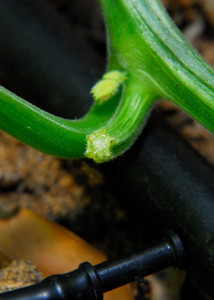
Until last night, there was a Gill's Golden Pippin squash attached to this nub
Vole Control Options:
Most of the literature we've read regarding vole control advocates the combined use of herbicides to control ground cover, and toxic baits to directly kill voles. Therein lies the problem. We don't use herbicides, or toxic baits, and so thus, it seems we have a herculean vole problem. We also don't have outdoor cats, as our indoor cat is more than 2 decades old, and has officially retired from mousing. He deserves it, don't you think?
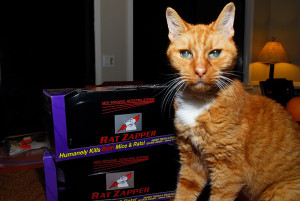
Our formerly formible Tigger, at more than 2 decades old, with cataracts, and diabetes, has officially retired from mousing. Which is unfortunate, as he was rather good at it!
We can keep some vegetative cover trimmed, stop planting cover crops, trap crops, and pull up the wildflowers we planted on the slope to curb erosion. This will decrease the available desireable vole habitat. The use of cover crops within 15 feet of any plants that need to be protected, like our fruit trees, is strongly advised against, as are layers of mulch near plants to be protected.

As gorgeous as the Goldfields were in bloom this spring, they provide the perfect cover for voles
Trapping, in small areas, can help to reduce populations, but requires a significant investment of time setting, and checking traps daily, throughout the year.
Poison baits have been proven to be generally effective at rapidly decreasing vole populations below damaging levels, but the risks of accidentally poisoning our poultry, pets, and area wildlife is too great to even consider using rodenticides.
To date, no repellents have been proven effective against Meadow Voles. None.
Our Vole Management Methods:
It's fair to say we're massively frustrated. This is the first time we've had to deal with meadow voles. Never, in anywhere we've gardened have they even been an issue. Now however, they're very much a part of our day to day reality.
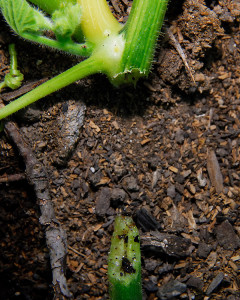
This morning this Boston Marrow squash stem was found with 4 inches of its main stem missing. A fruit was forming at the top of the photograph, but now separated from the roots, can only be used as compost
At times in recent weeks I've wanted to go charging across the squash patch 'Braveheart' style with a shovel, to engage in a satisfying round of whack-a-vole. At times I've wanted to scream, or cry. At times I've come close to wanting to quit, or move. Voles are the scourge of the organic farm and garden, and far more detrimental to crops than any other rodent we've ever encountered. Up until now, gopher damage, and squirrel damage, was minor in comparison to what we're experiencing this year with meadow voles. They're vile, they're vicious, voracious, and deservingly vilified by those who have to live with them.
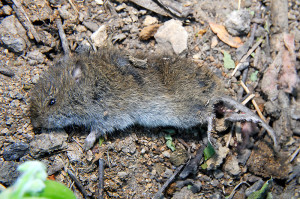
Note that voles have more rounded faces, and significantly shorter tails, than mice
Our crops planted in raised beds, with 1/4″ wire screen bottoms, have been effective at keeping gophers out, but the voles just run right up the sides of the beds, and move right in.
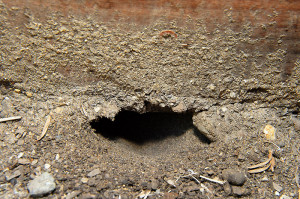
Our raised beds are all lined with 1/4" hardware cloth for gopher abatement, but this vole tunnel under our lettuce bed is still too close for comfort
Fruit trees that we thought were armored beyond breach, have been damaged beyond recovery.
The squash, and tomatoes we expect by summer's end, may be a total loss. Any squash that is produced, we'll consider a bonus.
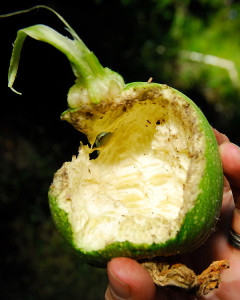
Even if the voles leave the stems intact, they're still decimating the fruits of this 'Baby Pam' pumpkin
If we don't get the vole population under control, quickly, growing any crops here may prove to be impossible.
We've considered acquiring a barn cat or two, but that would likely prove more deleterious to our resident song-bird and lizard populations, than to the voles, and most cats in this area don't survive for very long due to our resident coyotes who prowl the area both day and night. I can't condemn a cat to that sort of end.

Coyotes, of which we have many, don't think twice about targeting house cats as prey
Ironically I spent hours yesterday defending our poultry pens, especially our poults, from a brazen bobcat that refused to leave, and is in no way afraid of me, which made for some very intense moments during our turf war. Come on Bob, give us a break, we've got an all-you-can-eat vole buffet on the farm. Stop messing around, and catch one…hundred of them! Pulleeeeze?
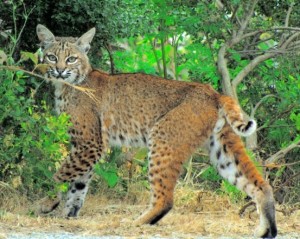
We know, it will take more than one Bobcat to wipe out the vole population, but if they'd stop harassing our poults, maybe they could at least help!
This isn't the first challenge to our gardens. Deer raided the orchard, so we bolstered fence security. Gophers killed some shrubs, and threatened fruit trees, we learned how to control them effectively. What though do we do about these blasted voles?
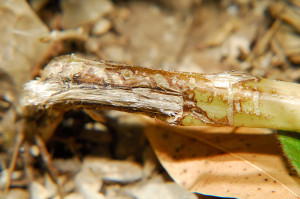
Vole damage to the stem of one of our 'Lemon Queen' sunflowers
Baits? Not if we can avoid it. I personally understand why it's used, really I do, and have had multiple arguments with myself in recent days over the use of baits. The answer however is still an emphatic NO.
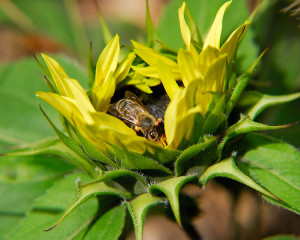
Despite a gnawed stem, and now laying flat on the ground, this sunflower is still trying to eek out a bloom
Do we stop growing vegetables? Noooooo way. I'll plant a thousand tomato plants if it means the voles might miss just one. Cut down the orchard? Absolutely not happening. Eliminate all the native wildflower stands because they're hiding places for these vile rodents? We might have to, at least for the short term, which saddens me greatly.
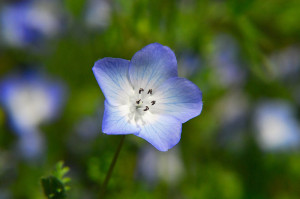
Some papers we've read suggest that plants in the genus Nemophila are a particular favorite of voles!
Do we eliminate cover crops altogether, and deprive our bees of forage? Again, not what we want, but probably sensible, at least for now.
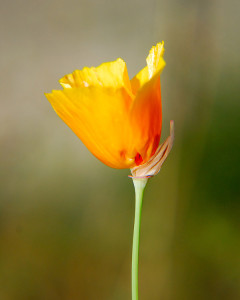
Instead of traditional cover crops, we planted native wildflowers, like this California poppy, to entice pollinators to the farm
As you may have deduced, meadow voles are a sustainable gardener/farmer's arch nemesis. Mulches used to conserve water and mitigate erosion, invite and conceal voles. Wildflowers grown to increase pollinator diversity, attract voles, and give them protection from predators. Cover crops used as green manures, and nectar sources for our bees, attract voles, and provide protective cover for them too. A creature the size of your big toe can wreak more havoc, and do more damage than an entire herd of deer, gang of gophers (what is a assemblage of gophers called?), or even squirrels (and they ran off with about 10% of the tomato harvest last year).
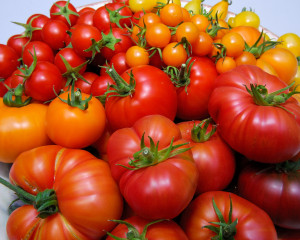
We were hoping for a robust tomato harvest this season, but so far it doesn't look very promising
Voles…this is war. The line in the sand has been drawn. When my bevy of new traps arrives this afternoon, the battle will begin, and we will not be defeated!
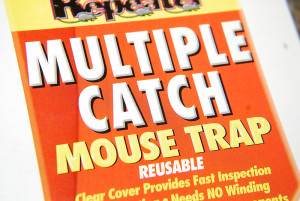
We'll try an assortment of traps to see which one is most effective
At least we hope not…but consider yourselves warned…
How To Catch California Voles In The Garden
Source: https://curbstonevalley.com/california-meadow-voles-a-sustainable-gardeners-nightmare/
Posted by: hubbardadminaraince79.blogspot.com

0 Response to "How To Catch California Voles In The Garden"
Post a Comment